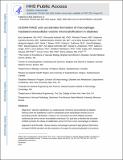S100A9-RAGE Axis Accelerates Formation of Macrophage-Mediated Extracellular Vesicle Microcalcification in Diabetes Mellitus
Author(s)
Kawakami, Ryo; Katsuki, Shunsuke; Travers, Richard; Romero, Dayanna Carolina; Becker-Greene, Dakota; Passos, Livia Silva Araujo; Higashi, Hideyuki; Blaser, Mark C; Sukhova, Galina K; Buttigieg, Josef; Kopriva, David; Schmidt, Ann Marie; Anderson, Daniel G; Singh, Sasha A; Cardoso, Luis; Weinbaum, Sheldon; Libby, Peter; Aikawa, Masanori; Croce, Kevin; Aikawa, Elena; ... Show more Show less
DownloadAccepted version (2.421Mb)
Open Access Policy
Open Access Policy
Creative Commons Attribution-Noncommercial-Share Alike
Terms of use
Metadata
Show full item recordAbstract
© 2020 American Heart Association, Inc. Objective: Vascular calcification is a cardiovascular risk factor and accelerated in diabetes mellitus. Previous work has established a role for calcification-prone extracellular vesicles in promoting vascular calcification. However, the mechanisms by which diabetes mellitus provokes cardiovascular events remain incompletely understood. Our goal was to identify that increased S100A9 promotes the release of calcification-prone extracellular vesicles from human macrophages in diabetes mellitus. Approach and Results: Human primary macrophages exposed to high glucose (25 mmol/L) increased S100A9 secretion and the expression of receptor for advanced glycation end products (RAGE) protein. Recombinant S100A9 induced the expression of proinflammatory and osteogenic factors, as well as the number of extracellular vesicles with high calcific potential (alkaline phosphatase activity, P<0.001) in macrophages. Treatment with a RAGE antagonist or silencing with S100A9 siRNA in macrophages abolished these responses, suggesting that stimulation of the S100A9-RAGE axis by hyperglycemia favors a procalcific environment. We further showed that an imbalance between Nrf-2 (nuclear factor 2 erythroid related factor 2) and NF-κB (nuclear factor-κB) pathways contributes to macrophage activation and promotes a procalcific environment. In addition, streptozotocin-induced diabetic Apoe-/-S100a9-/- mice and mice treated with S100a9 siRNA encapsulated in macrophage-targeted lipid nanoparticles showed decreased inflammation and microcalcification in atherosclerotic plaques, as gauged by molecular imaging and comprehensive histological analysis. In human carotid plaques, comparative proteomics in patients with diabetes mellitus and histological analysis showed that the S100A9-RAGE axis associates with osteogenic activity and the formation of microcalcification. Conclusions: Under hyperglycemic conditions, macrophages release calcific extracellular vesicles through mechanisms involving the S100A9-RAGE axis, thus contributing to the formation of microcalcification within atherosclerotic plaques.
Date issued
2020Department
Massachusetts Institute of Technology. Institute for Medical Engineering & ScienceJournal
Arteriosclerosis, Thrombosis, and Vascular Biology
Publisher
Ovid Technologies (Wolters Kluwer Health)